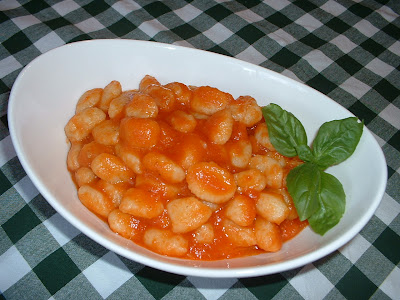
Potatoes do find their way into many interesting and tasty dishes and sometimes without getting any recognition or fame they remain incognito.
Unless Potato Gnocchi is homemade or ordered from a restaurant menu, one may not recognize the star ingredient.
Among the many ways Potato Gnocchi are presented they’re often served smothered in a wonderful tomato sauce or tossed in a zesty pesto with plenty of grated cheese. The gnocchi become the little vehicles that carry whatever flavours you may desire.
The various regions of Italy have their own version of the perfect gnocchi. They are made with anything ranging from potatoes, cornmeal, buckwheat, squash, spinach or ricotta cheese. In the more northern regions they are even made with rye bread crumbs.
Other than using potatoes I have also made them with ricotta cheese. These are lighter and less starchy while the potato gnocchi tend to be wonderfully dense and chewy and of course contain more starch.
I have a recipe for squash gnocchi that is patiently waiting in my “Recipes to Try out File.” It’s been there for sometime as I am not particularly fond of squash.
One day soon I hope to be brave enough to try the recipe and decide whether it needs to graduate into the “Tested and True” collection or find its way into another file like “Tested and Trashed.”
I’ve made gnocchi using three different tools. Some may prefer to make gnocchi by rolling strands of dough then cutting or pinching off small pieces of the dough. I prefer the shape of hollow ridged shells.
My first gnocchi were made on a rustic hand made basket that came from Calabria my husband’s hometown in Italy. While on vacation my sister brought back a wooden gnocchi paddle from Alberobello, Italy for me and I also bought a machine that cranks them out by the dozens.
My favourite tool by far is the gnocchi paddle and a fork. When no one else is around I love to sit at the kitchen table, let my mind wander and individually shape each little gnocchi by hand.
Before I know it I’ve made hundreds of little treasures ready to be served for dinner.
Potato Gnocchi
3 medium size potatoes (about 1 pound)
1 ¾ cups all purpose flour
- Wash, peel and cut potatoes into quarters.
- Cook in salted water until tender (about 20 minutes)
- Drain water and shake pan over low heat to dry potatoes off.
- Mash or rice potatoes and keep warm.
- Measure flour onto a bowl and make a well in the center of the flour.
- Add hot mashed potatoes to flour and mix well.
- Turn dough out onto a floured surface and knead until smooth and elastic.
- Roll out dough to about ¾ inch thickness, cut into ¾ inch wide strips.
- With hands roll each strip just to make them cylindrical.
- With fingers pinch off 1 inch pieces of dough, place on gnocchi paddle and curl each piece by pressing a fork on the piece of dough and pulling the fork towards you.
- Lay the gnocchi on a baking sheet that has been lined with a clean tea towel.
- Place pan in freezer until gnocchi are firm then place in freezer bags and store in freezer until ready to use
- To cook, bring a large pot of salted water to a boil. Add the gnocchi and stir to make sure they don’t stick.
- When gnocchi rise to the top they’re ready, scoop out with a slotted spoon.
- Drain well and add your favourite sauce. Makes 4 servings.
Notes, Tips and Suggestions
- Even when you want to serve the gnocchi the same day freeze them while still on the tray. This makes them easier to handle and they’re less likely to stick together when you cook them.
- Make sure the potatoes are hot when you mix them to the flour, use a rubber spatula at the beginning so you don’t burn your hands.
- Dough will be a little sticky but try to use as little extra flour as possible. This will ensure the gnocchi remain tender.
- Finely chop your favourite herb and add to the gnocchi dough before shaping for extra flavour.





Tools of the Trade
The basket did a great job making the gnocchi but it was wearing out so I was glad to replace it with the wooden paddle.
As mentioned, the paddle I use was purchased in Italy but I was also able to find one at Golda’s Kitchen in Mississauga Ontario.
The machine makes gnocchi as well as cavatelli pasta. I occasionally use the machine but there’s just something so satisfying about making the gnocchi by hand.
























